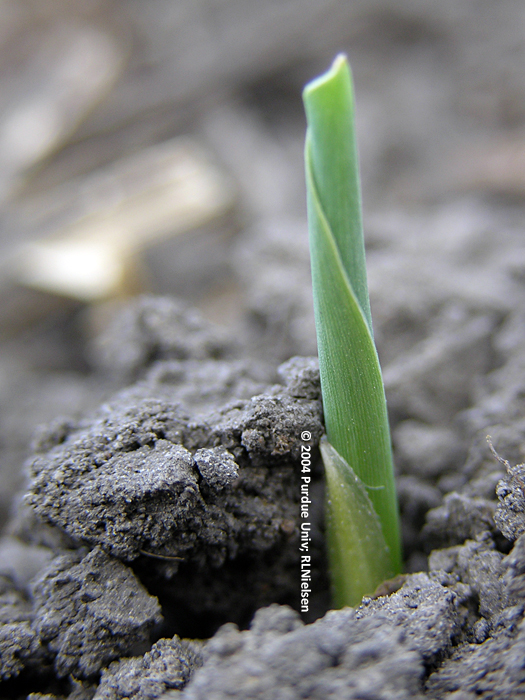By R.L. (Bob) Nielsen
Agronomy Dept., Purdue Univ.
Successful stand establishment of a corn crop relies on many factors, including the successful emergence of the seedlings. Seedling emergence occurs as a result of elongation of the mesocotyl that elevates the coleoptile or “spike” toward the soil surface. If successful, the appearance of the coleoptile at or near the soil surface is synchronized with the emergence of the first true leaf from inside the coleoptile.
The mesocotyl is the white tubular stem-like plant part located between the kernel and the base of the coleoptile. Technically, the mesocotyl is the first true stem internode of the young corn seedling. As the coleoptile nears the soil surface, exposure to the red wavelengths of solar radiation causes a change in the supply of one or more growth hormones from the coleoptile to the mesocotyl tissue and mesocotyl elongation comes to a halt (Vanderhoef & Briggs, 1978). If mesocotyl elongation and/or coleoptile emergence are compromised, the emergence of the leaves from the coleoptile may occur underground and remain trapped by the soil.

Reports of leafing out underground in 2012, the year of record early planting, are beginning to accumulate now that growers are beginning to walk their early-planted fields. Such "leafing out underground" is obviously viewed with great consternation by growers who were hopeful for perfect emergence of their crop. Obviously, emergence failure directly impacts effective plant population; one of the major yield components of corn. The extent of the emergence failure in affected fields appears to range from about 5 to 20 percent of the planted population. The magnitude of the effect on grain yield will depend on the initial seeding rate, the severity of the problem, and growing conditions the remainder of the season. Very few affected fields, however, likely merit a decision to replant.
Failure to emerge successfully can be caused by failure of the mesocotyl to successfully elongate and/or by soil restrictions that hinder successful penetration of the soil by the coleoptile. In extreme cases, elongation of the mesocotyl fails miserably, resulting literally in corkscrewed fiascos. Often, more than one of the following causal factors exist in a problem field and usually interact with each other to amplify the problem.
Kernel Position in Furrow: The coleoptile, the protective covering for the plumule leaves, emerges from the embryo side of the kernel and moves toward the dent end of the kernel by virtue of the elongation of the mesocotyl. The position of the kernel in the furrow with respect to the embryo face directly influences the initial location where the coleoptile emerges. If the kernel lands with the embryo face down in the furrow, the coleoptile emerges on the bottom side of the kernel, elongates horizontally until the mesocotyl "clears" the end of the kernel, then finally begins its upward ascent. Such an “upside-down” beginning might contribute to a seedling’s susceptibility to other corkscrewing causal factors.
Restricted Emergence: Corkscrewed mesocotyl/coleoptile development can result when the coleoptile encounters resistance as the mesocotyl elongates. Severe soil crusting or otherwise dense soil surface and cloddy soil surfaces can cause such resistance. A combination of severe sidewall compaction plus press wheel compaction over the furrow can also restrict coleoptile emergence and force the mesocotyl to elongate in unusual directions.
Herbicide Injury: Certain herbicides, notably cell growth inhibitors like acetochlor, can affect seedling shoot development especially if weather or soil conditions are not conducive for rapid seedling growth. However when herbicide injury is suspected to be a contributing factor, cool soils and dense soil crusting are often also contributing factors, so is difficult to pin the blame completely on the herbicide injury.
Cold Soils: Cold soils and/or wide fluctuations in soil temperatures throughout the day during the emergence process are also thought to be major contributing factors for the development of corkscrewed mesocotyl development (Buckle & Grant, 1974). The exact minimum soil temperatures that can cause such corkscrewed development are not clearly documented, but clearly it is not uncommon in Indiana for daily soil temperatures to dip as low as 40F during April and early May. Furthermore, bright sunny days can elevate bare soil temperatures quite high but still drop quite low the following night and thus result in a wide diurnal fluctuation in soil temperatures. Dry soils would be more prone than wetter soils to wide swings in daily soil temperatures.
Corny Trivia: Cold temperature injury that results in corkscrewed mesocotyls is not exactly the same as that which is referred to as "imbibitional chilling" injury. The latter refers to cold injury to the seed during the first 24 to 72 hours after planting when the seed is imbibes (aka absorbs) water. Imbibition of water causes the seed to swell. If seed cell tissue is very cold, it may become less elastic and thus may rupture during the swelling process. The most common symptom of such imbibitional chilling damage to seed cell tissue is often simply swollen seed with little to no evidence of germination progress. Conversely, seedlings with corkscrewed mesocotyls germinated successfully. The cold temperature damage occurred slightly later, during the early stages of mesocotyl elongation and affected the mesocotyl tissue, not the seed tissue.